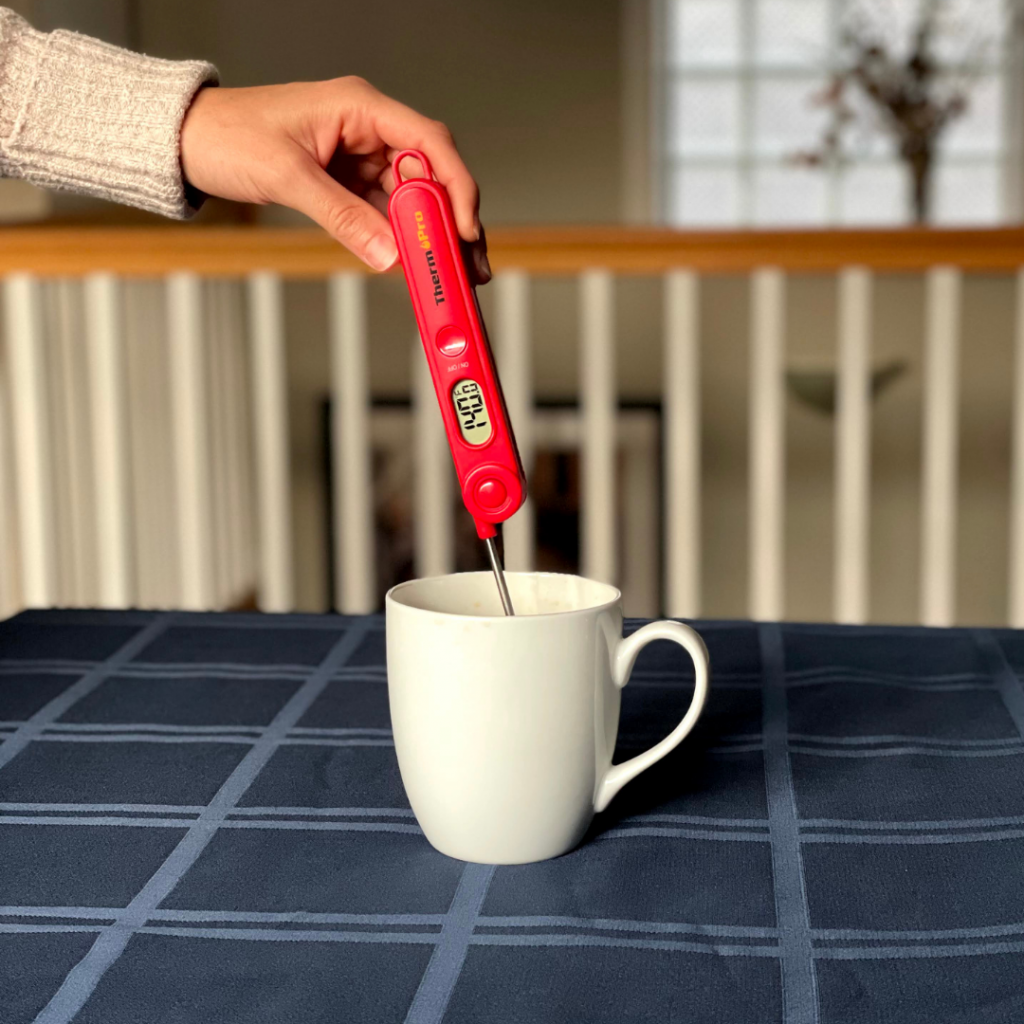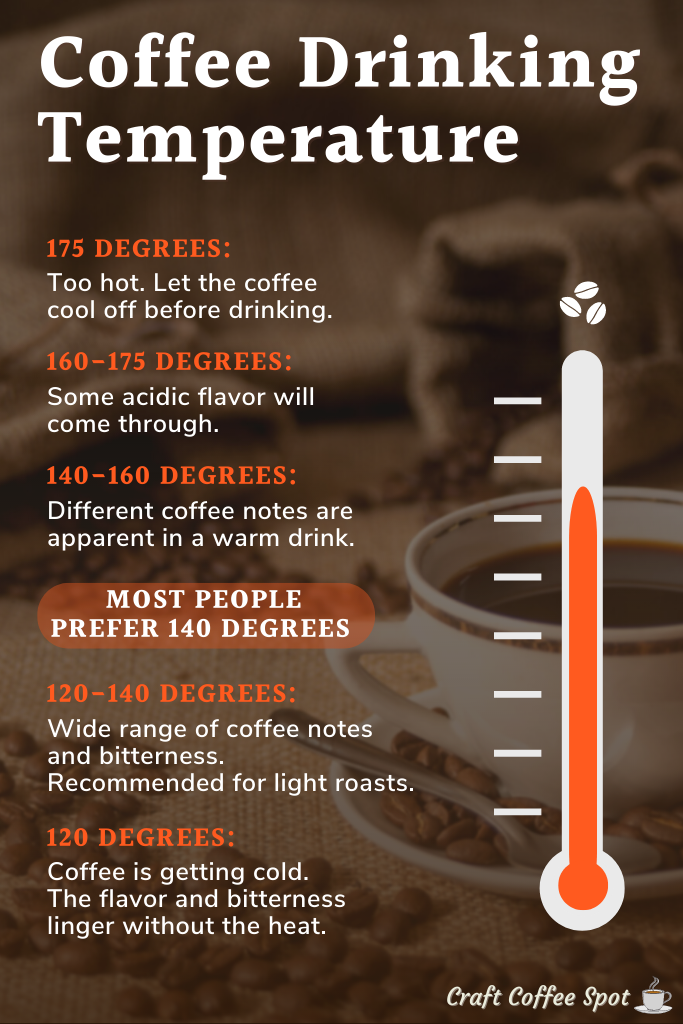The coffee community is divided over the optimal temperature for both brewing and drinking coffee. This difference in opinions isn’t just about personal tastes—there’s a significant body of research addressing this very question.
To provide a comprehensive answer, I spent hours checking scientific studies, and I also conducted my own experiments with various brewing temperatures.
All the information is summarized here, including what’s clear (water brewing temperature) and what’s not (like coffee drinking temperature). I summarized my findings in a broad FAQ – feel free to jump to a section to get started:
What Is the Best Water Temperature for Brewed Coffee?
The Specialty Coffee Association (SCA) recommends brewing coffee using hot water at 195 – 205 degrees F (about 90-96 C). The SCA is the organization that most baristas and Q graders follow. In general, if the coffee industry uses 195 to 205 degrees for brewing coffee, the rest of us should follow.
This hot water temperature maximizes coffee extraction during brewing. Extraction is a chemical reaction that removes soluble oils from the coffee bean into brewed coffee.
Coffee extraction requires a solvent (water) and energy (heat). Higher brewing temperatures speed up coffee extraction. Since we all want to have our coffee as soon as possible, we use a high temperature to brew coffee.
Can You Use Boiling Water for Brewing Coffee?
Most coffee roasters advise against using boiling water for coffee. The common view is boiling water scalds coffee and over-extracts soluble oils, which leads to a bitter taste. I believe it’s perfectly fine to use boiling water for brewing coffee, as long as you reduce the brew time.
There isn’t clear evidence that boiling water results in over-extraction or “scalding” of the coffee beans. After all, coffee beans are already roasted at 385 degrees, well above boiling temperature.
One study found people didn’t notice any difference in taste when drinking coffee brewed at different temperatures. Granted, the study did find extraction levels had a big impact on taste. So while water temperature in itself doesn’t affect the taste of brewed coffee, the temperature does lead to more extraction, and extraction affects taste a lot.
What we can conclude from this is that boiling water is fine, but make sure to account for it with a shorter brew time!
I recommend brewing coffee using 195 to 205 degrees F because it is the SCA standard. If using boiling water, make sure to shorten brew times. It helps to try coffee at different temperatures and brew with what tastes best.
A final note on using boiling water: Using boiling water makes sense because water cools as it exits the kettle and mixes with the coffee beans. One experiment found boiling water was 200 degrees once it contacted the coffee grounds. For all the people who say boiling water scalds coffee beans, it may not even be possible to do it. It takes a minute or two for boiling water to cool to the standard range of 195 to 205 degrees.
Does the Brewing Temperature Change for Different Types of Coffee?
No, the brewing temperature doesn’t change for different types of coffee. Use 195-205 degrees for all types of coffee brewing (drip, pour-overs, and immersion devices).
Most brewing recipes will vary the time to brew instead of the water temperature. Cold brew coffee is the exception, where water is at room temperature or refrigerated. Cold brew also takes 12 hours to brew, which shows the trade-off between heat and extraction time.
Light roasts need a higher water temperature. Light roast beans have more soluble oils because of their shorter roasting time. Make sure to increase the temperature or time to fully extract flavor from a light roast. Light roasts will taste more acidic (sour) if they are under-extracted.
Meanwhile, dark roasts have a longer roasting process, which extracts more coffee solubles. Use a lower brewing temperature or brew time for dark roasts. Dark roasts will taste particularly bitter if they are over-extracted.
What Is the Best Coffee Temperature for Drinking?
The sweet spot for drinking coffee is 140 degrees, which brings out the most coffee flavor without burning the tongue. According to a Research Gate study, most people prefer drinking coffee at 140 degrees. Another study found that 136 degrees was the best temperature when considering personal preference and burn risk.
There is a wide range of preferences on the right temperature for drinking coffee. This is mainly because the coffee flavor changes at different temperatures.
Higher temperatures activate flavor receptors on the tongue. This explains why warm beer is bitter and melted ice cream is sweet. Similarly, the temperature of coffee makes a big difference in perceived taste. A Science Direct study found that temperature was more important than the blend in judging coffee’s taste.
My Coffee Temperature Experiments and Findings
After reviewing all the studies, I conducted an experiment on coffee temperature. I used a basic kitchen thermometer to record the coffee temperature before each sip and wrote down the flavors. Surprisingly, the coffee did taste different with every 10-degree change in temperature.

The delicate notes of flavor come out when coffee is cooler at 120 degrees, along with the acidity and bitterness. As the temperature increases above 160 degrees, the burning sensation of hot coffee overpowers the flavor.
The National Coffee Association (NCA) recommends serving coffee at 180 degrees. I found this coffee temperature was way too hot. Their recommendation might be informed by the evolutionary bias towards preferring hot beverages. That might be a good thing for the world, as the University of Colorado Boulder found people who held a hot cup of coffee judged others as more generous and caring.
But, there are safety risks with drinking extremely hot coffee. Hot beverages can cause burns starting at 116 degrees, and regular hot coffee drinkers are actually less sensitive to sweet flavors.
Clearly, there isn’t an optimal temperature to drink coffee. It depends on how much you prefer warmth versus flavor. Here is how I found the coffee flavor at different temperatures.

Over 175 Degrees: Too Hot
Coffee at or above 175 degrees will burn the taste buds. There isn’t any noticeable coffee flavor at this temperature either. The only reason to serve coffee at 175 degrees is so it can last for some time.
160-175 Degrees: Hot with Some Flavor
Coffee tastes “hot” from 160 to 175 degrees but it’s drinkable. There isn’t much flavor at this heat level. I noticed brief acidity or bitterness at the start of each sip. The aroma is strong at these temperatures. I recommend 160-175 degrees if it’s a cold morning, or if you’re drinking a low-quality cup for caffeine.
140-160 Degrees: A Lot of Flavor and Warmth
This is the sweet spot for enjoying hot, quality coffee (for me, at least). Coffee at 140-160 degrees warms the body. You’ll notice the roast flavor and trademark bitterness of the coffee. This coffee temperature is good for dark roasts, and people who like the warmth from a hot beverage.
120-140 Degrees: Bursting with Flavor and Warmth
The full range of coffee flavors is really noticeable at 120 to 140 degrees. Each sip lingers for a few seconds as the taste buds assess the full range of delicate notes and acidity. The coffee is no longer “hot” under 140 degrees but it feels warm. 120 to 140 degrees is a good temperature for any craft coffee, particularly a light roast with different notes.
Under 120 Degrees: “Cold” but Tasty
At this point, the coffee is “cold”. The tongue is no longer reacting to the heat. This allows the flavor to linger in the mouth and become noticeable. It was hard to get over the perception that this coffee was “cold”. It’s best to pour coffee over ice once it gets close to 100 degrees.
What Temperature Should Your Coffee Be?
Finding the ideal coffee temperature is less about one-size-fits-all and more about personal preference and the nature of the coffee itself. Brew your coffee between 195 and 205 degrees Fahrenheit for optimal extraction, and try drinking it around 140 degrees to enjoy a balance of flavor without discomfort. Remember, the perfect cup is the one that tastes best to you.
Now that you know the right temperature to brew and drink coffee, read our coffee brewing guides to make your next batch of craft coffee.




